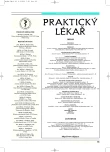Ergomentry under physical load
Zátěžová ergometrie
Zátěžová ergometrie představuje jednoduchou a široce používanou vyšetřovací metodu. Kardiologické společnosti různých zemí vytvořily společné postupy, které vyjadřují současný postoj kardiologické veřejnosti k tomuto vyšetření. Cílem naší práce je seznámit širokou lékařskou veřejnost se současným stavem této problematiky. Článek stručně shrnuje základní principy tohoto vyšetření, jeho indikace, kontraindikace a rizika. Zmíněny jsou všechny zásadní informace z doporučení České i Evropské kardiologické společnosti a diskutována jsou doporučení americká, jejichž součástí jsou novější indikace, především zátěžová ergometrie u pacientů s nestabilní angínou pectoris a u asymptomatických nemocných s těsnou aortální stenózou. Zvláštní pozornost je věnována senzitivitě a specificitě této vyšetřovací metody. Jsou popsány stavy, kdy je zátěžová ergometrie nepřínosná a je nutno použít zobrazovacích metod. Článek má seznámit lékaře se zátěžovou ergometrií, jejími výhodami i limitacemi.
Klíčová slova:
zátěžová ergometrie - tepová frekvence - tolerance zátěže - EKG.
Authors:
V. Bureš
Authors‘ workplace:
Poliklinika 2, Olomouc
; Nestátní interní oddělení, kardiologická ambulance
Published in:
Prakt. Lék. 2006; 86(2): 85-88
Category:
Diagnostis
Overview
Ergomentry under physical load represents a simple and widly applied investigational method. Cardiological societies in various countries have elaborated common procedures that express the present standpoint of the cardiological public to this procedure. The objective of the paper is to acquaint the broad medical public with the present state of this problem. Summarized are briefly the principles of the investigation method, its indications, contraindications, and risks. Mentioned are all basic pieces of information and recommendations of the Czech and European cardiological societies, and discussed are American recommendations that include newer indications, first of all burden ergomentry in patients with unstable angina pectoris and in asymptomatic patients suffering obturating stenosis of the aorta. Special attention is given to the sensitivity and specificity of the methopd. Described are states in which the method does not contribute to our knowledge and picturing methods have to be used. The article is to inform physicians about burden ergometry, its advantages as well as its limits.
Key words:
burden ergometry – pulse frequency – burden tolerance – ECG.
Labels
General practitioner for children and adolescents General practitioner for adultsArticle was published in
General Practitioner

2006 Issue 2
- Metamizole at a Glance and in Practice – Effective Non-Opioid Analgesic for All Ages
- Memantine in Dementia Therapy – Current Findings and Possible Future Applications
- Advances in the Treatment of Myasthenia Gravis on the Horizon
- Possibilities of Using Metamizole in the Treatment of Acute Primary Headaches
- Hope Awakens with Early Diagnosis of Parkinson's Disease Based on Skin Odor
Most read in this issue
- Group B Streptococcus infection, screening, treatment - recommendation
- IgA nephropathy – the most common primary glomerulonephritis worldwide
- Ergomentry under physical load
- The long pentraxin PTX3 – a new acute phase reactant
